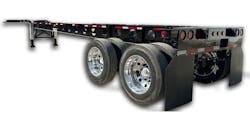GRAPEVINE, Texas — In his 35 years in the trucking industry, McLeod Software CEO Tom McLeod said he’s never seen a wider variety of challenges. These challenges—such as inflation, supply chain woes, capacity crunches, and driver shortages—are also creating opportunities for well-run fleets and freight brokers.
The Consumer Price Index (CPI), which measures inflation, “has been at about 2% a year for almost 20 years,” McLeod said during his keynote address opening up the McLeod Software User Conference 2021 on Sept. 13. “So we’ve really enjoyed some great economic times. And that could be about to change.”
According to the Bureau of Labor Statistics, the CPI was up 5.4% over the previous 12-month period at the end of July. “So what does that mean for you?” he asked a large crowd of McLeod customers and vendors gathered at the Gaylord Texas Convention Center for the three-day user conference that kicked off the night before.
“That means it’s more important than ever that you stay on top of your pricing,” McLeod continued. “It’s very important to keep your rates in line, that you stay in touch with what’s going on in the market, that you understand what’s happening, and that you make the right moves at the right time. If prices are stabilizing, you need to be able to see that. If prices are spiking, you’ve got to be able to react.”
McLeod noted that during the previous capacity crunch in 2018-19, freight rates were higher in 2018 with less freight to move. That flipped in 2019. “How many of you can remember that freight actually felt softer in 2019? Right in the midst of the driver shortage, somehow enough companies found a way to add capacity that freight felt softer even though it was up—and rates came down,” he explained. “So capacity compared to the amount of freight being hauled is the key to rates being where they need to be.”
Less than a year later, the COVID-19 pandemic began, “and things have gone haywire,” McLeod said.
During the past 18 months, freight has been affected by a driver shortage, equipment shortage, declines in manufacturing, and supply chain issues. “Just the fact that there are fewer drivers available may account for less capacity right now,” he said. “Capacity being constrained is the key to your rates being where they are—so that’s something to be grateful for.”
This strain, however, is creating opportunities for carriers to adjust their freight networks. “If you’ve had customers that have been difficult to work with, this may be a great time to think about replacing that customer,” McLeod said. “You can be selective on which loads you take. And those customers you’ve always wanted to call on who would never see you, they’ll see you now. You go see them. They’ll talk to you now. And if you come through for them in this time of restrained capacity, they are a whole lot more likely to stay loyal to you afterward.”
McLeod advised his customers in attendance to get themselves “into a position to be running a great operation when conditions change—and we’re expecting them to get better.” He added that while things will get better, there is no going back to how it was pre-COVID. “Don’t just be hanging on, closing your eyes, waiting for this big thing to be over. It’s not going to be over—we’re in a state of transition.”
One of the big disruptions in transportation is the supply chain. McLeod showed the crowd a photo of hundreds of trucks parked at the Kentucky Motor Speedway “not on a race day. These are vehicles that have been manufactured. They’re ready to go to the dealer—except they’re missing two chips.”
There are thousands of vehicles all over the nation that are all but complete, just missing important semiconductor microchip. This has led some factories to pause manufacturing as the microchip supply has dried up.
It’s not just vehicle manufacturers feeling the pinch of supply chain troubles. Restaurants and other businesses have been forced to adjust prices and menu offerings on the fly as supply has fallen short of demand. “We’re seeing disruptions I don’t recall seeing in my lifetime,” McLeod added. “So if you’re experiencing that, your shippers are experiencing that. So it’s very important to stay in continuous communication with your customers as we go forward.”










